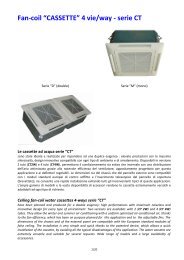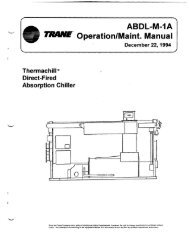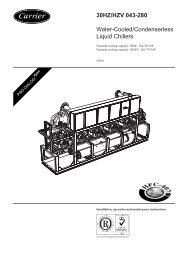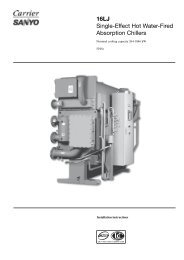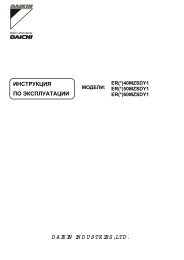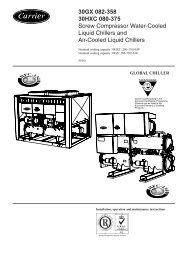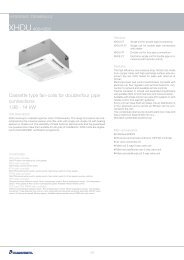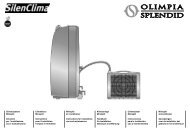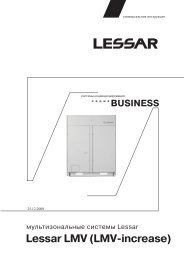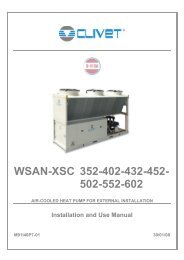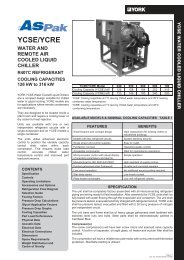"A" Ductable Liquid Chillers with Integrated Hydronic Module
"A" Ductable Liquid Chillers with Integrated Hydronic Module
"A" Ductable Liquid Chillers with Integrated Hydronic Module
Create successful ePaper yourself
Turn your PDF publications into a flip-book with our unique Google optimized e-Paper software.
2 - PRELIMINARY CHECKS2.1 - Check equipment received• Inspect the unit for damage or missing parts. If damage isdetected, or if shipment is incomplete, immediately file aclaim <strong>with</strong> the shipping company.• Confirm that the unit received is the one ordered.Compare the name plate data <strong>with</strong> the order.• The unit name plate must include the followinginformation:- Version number- Model number- CE marking- Serial number- Year of manufacture and test date- Refrigerant used and refrigerant class- Refrigerant charge per circuit- Containment fluid to be used- PS: Min./max. allowable pressure (high and lowpressure side)- TS: Min./max. allowable temperature (high and lowpressure side)- Globe valve cut-out pressure- Pressure switch cut-out pressure- Unit leak test pressure- Voltage, frequency, number of phases- Maximum current drawn- Maximum power input- Unit net weightHigh pressure Low pressureMin. Max. Min. Max.PS (bar) -0.9 32 -0.9 25TS (°C) -20 72 -20 62Pressure switch cut-out pressure (bar) 29 -Valve cut-out pressure (bar) - 25Test pressure, unit leak test (bar) 15• Confirm that all accessories ordered for on-site installationhave been delivered, and are complete and undamaged.• The unit must be checked periodically during its wholeoperating life to ensure that no shocks (handlingaccessories, tools etc.) have damaged it. If necessary, thedamaged parts must be repaired or replaced. See alsochapter “Maintenance”.2.2 - Moving and siting the unit2.2.1 - MovingSee chapter "Installation safety considerations"2.2.2 - Siting the unitAlways refer to the chapter "Dimensions and clearances" toconfirm that there is adequate space for all connections andservice operations. For the centre of gravity coordinates, theposition of the unit mounting holes, and the weight distributionpoints, refer to the certified dimensional drawing supplied<strong>with</strong> the unit.CAUTION: Only use slings at the designated lifting pointswhich are marked on the unit.Before siting the unit check that:• the permitted loading at the site is adequate or thatappropriate strengthening measures have been taken;• the surface is horizontal, flat and intact;• a channel is provided all the way around the unit to collectthe condensate water.• if the unit is not equipped <strong>with</strong> the accessory condensaterecovery pan, reference is made to the installation conditionsin chapter 10.4;• there is adequate space above the unit for air flow;• there are adequate support points and that they are in theright places;• the location is not subject to flooding;• units <strong>with</strong> the outdoor installation option should not beinstalled where there is a risk of snow build-up. In areasthat are subject to long periods of sub-zero temperaturesraise the unit to a higher level.Baffles may be necessary to deflect strong winds and toprevent snow from blowing directly into the unit. Theymust not restrict air flow into the unit.CAUTION: Before lifting the unit, check that all casingpanels are securely fixed in place. Lift and set down the unit<strong>with</strong> great care. Tilting and jarring can damage the unit andimpair unit operation.The 30RY units can be hoisted <strong>with</strong> rigging. Coils shouldalways be protected against crushing while a unit is beingmoved. Use struts or spreader bars to spread the slings abovethe unit. Do not tilt a unit more than 15°.WARNING: Never push or lever on any of the enclosurepanels of the unit. Only the base of the unit frame is designedto <strong>with</strong>stand such stresses.7



